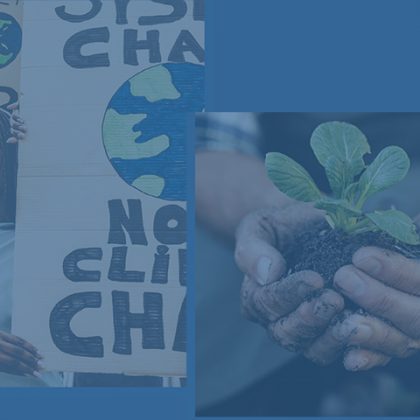Conversations with Authors: Without Roots: The Political Consequences of Collective Economic Shocks
In this “Conversation with Authors,” we spoke with APSR authors Simone Cremaschi, Nicola Bariletto, and Catherine E. De Vries about their open access article “Without Roots: The Political Consequences of Collective Economic Shocks”.
APSR: Let us start with some general questions:
For those who haven’t read your article (yet!), could you give a very brief summary of your key argument or arguments?
Simone Cremaschi, Nicola Bariletto & Catherine E. De Vries (The Authors): Our study, Without Roots: The Political Consequences of Collective Economic Shocks, looks at what happens when an entire community faces a crisis that threatens both their livelihood and way of life. We focus on the Xylella epidemic in Puglia, a region in southern Italy, where a plant disease wiped out centuries-old olive groves—one of the region’s economic and cultural cornerstones. What we found is that when socio-economic hardship is shared collectively rather than experienced in isolation, the political consequences run deep. Communities that watched their landscape and livelihood disappear didn’t just suffer financially and socially; their political attitudes shifted. They became more distrustful of mainstream parties and more drawn to radical movements—especially in areas where skepticism toward the state was already strong. The bigger picture? Shocks like Xyllela don’t just affect individuals through job or income loss, they reshape entire communities. They affect how communities see politics, and based on prior experiences with the state, make communities more receptive to political messages about state neglect and anti-elite sentiment. By doing so, the shock drove far-right support and may rewrite the political map for years to come.
APSR: We’d like to know a bit about the inspiration behind and origins of this project. What motivated this study and how did it develop over time?
The Authors: The story behind our paper is quite personal and deeply connected to the broader goals of the European Research Council (ERC)-funded project LOSS, which supported our work. It all started with Simone’s PhD fieldwork in Puglia, where he was studying immigrant agricultural workers. While there, he kept hearing about the Xylella epidemic—a devastating plant disease—and started wondering about its political consequences. At the same time, Nicola had just joined the team as a pre-doctoral researcher. Having grown up in Puglia, he understood firsthand how central olive cultivation is to the region’s economy and cultural identity. So, when Simone brought up the idea, he was immediately eager to explore it further. Catherine’s ERC project, which examines how economic shocks influence public service provision and support for socially conservative parties, provided the perfect framework to investigate these questions in-depth. The Xylella epidemic became a natural case study for exploring LOSS’s core themes. With the help of an amazing team of research assistants, everything came together. Over the next few years, we dove deep into the topic, uncovering the political ripple effects of the Xylella outbreak.
APSR: What was the most challenging/difficult part of the research process?
The Authors: Without a doubt, the biggest challenge was integrating quantitative and qualitative approaches. When we first started, our project wasn’t designed as a mixed-method study—we had clear expectations about the political effects of a shock like Xylella and set out to test them using quantitative data. But as we dug deeper, we realized numbers alone couldn’t fully explain the underlying mechanisms driving our results. At that point, Simone had just completed fieldwork for another project on the long-term effects of political memory, using interviews and participant observation to uncover causal relationships that statistical analysis couldn’t fully capture. That experience gave us a lightbulb moment: a similar qualitative approach could help us bridge the gaps in our quantitative analysis. This led us to develop a new case-selection method that aligned closely with the counterfactual logic of our difference-in-differences design, giving us a much clearer picture of how the Xylella outbreak affected local economies, community histories, and political identities. That said, integrating these two approaches was anything but straightforward. We had long and, at times, heated discussions about how different methodological traditions define causality and what counts as valid evidence. While we haven’t resolved every tension, we’ve found a way to make these methods work together, creating a more nuanced and well-rounded understanding of our findings. The APSR review process was incredibly valuable in pushing us to clarify the distinct contributions of both approaches, ultimately strengthening our work.
APSR: When you were writing this piece, was there something that really surprised, confounded, or excited you?
The Authors: A key insight from analysis that was really surprising to us was the importance of a community narrative of state neglect. In our quantitative analysis, we found this robust heterogenous effect of distance to public service hubs. From previous work, we already knew that public services are important political markers for people, but we didn’t know how to exactly make sense of it in the context of Xyella. Here is where the work from cultural sociology on community narratives and our fieldwork came in – we wanted to better understand how communities attach meaning to their experiences with Xyllela. The qualitative fieldwork strengthened our intuition that residents of a community in which the outbreak generated a substantial far-right shift embraced a narrative of being left behind by the state and interpreted the epidemic as a product of this neglect. Yet, surprisingly to us, we found that in an equally affected community where the far right did not gain substantially from the epidemic, residents actually displayed an opposite, and quite positive, community narrative about the state. This was surprising to us, which we explicitly acknowledged in the paper. A local historian suggested that the presence of a railway since the nineteenth century had played a pivotal role, a story we also document.The fact that our interviewees offered these accounts without prompting, increased our confidence that we were on to something – that the community narrative of state neglect was very important for understanding the political consequences of Xylella.
APSR: Turning now more specifically to your article:
The title of your article, “Without Roots,” refers to the Xyllela plant disease, ravaging olive trees, that is at the heart of your article. Earlier iterations of the manuscript focused even more on the plant disease part of the story. How did the idea of examining the political consequences of a plant disease epidemic come about?
The Authors: As we mentioned already, the focus on Xylella arose from a personal connection to Puglia. Simone did his PhD fieldwork there, Nicola is from there, and Catherine when moving to Italy heard about it for the first time. This made us wonder about the political consequences. We had all heard about the Irish famine that was connected to the potato pathogen Phytophthora infestants and reshaped Irish society, so we wanted to know more about Xylella. Xyella and its devastating effects also unfolded in a short timespan, which provided us with a unique lens for studying the effects of a collective shock. The rapid onset and local concentration of the outbreak allowed us to study decline in communities – loss of economic livelihood, youth outmigration, etc. – that are usually conflated in longer-term macro-structural processes of change due to deindustrialization, for example. As we progressed with the project, we thus realized that the Xylella outbreak doesn’t only tell us something about the political consequences of a plant disease epidemic, but is a case of a collective economic shock.
APSR: One of the theoretical innovations of your paper is the focus on communal, rather than individual, effects. What made you want to study the collective effect, rather than individual, effect of economic shocks? Did you face any challenges because you are studying community level effects?
The Authors: Many recent studies on economic decline and far-right support acknowledge that economic shocks affect entire communities, not just individuals. However, most research still focuses on individual attitudes and behaviors. This is largely due to methodological constraints—traditional survey data often struggles to capture the broader, community-level dynamics that drive political shifts. Scholars like Katherine Cramer have shown how these local interactions shape political outcomes, but measuring them systematically remains a challenge. To tackle this, we combined quantitative analysis with qualitative fieldwork, allowing us to bridge the gap between large-scale data trends and the lived experiences of affected communities. Of course, as we discussed earlier, integrating these methods is far from easy. It requires navigating different ways of understanding causality and evidence. But we saw this as both a necessary and valuable step toward capturing the deeper political consequences of collective economic shocks.
APSR: You argue that “plant diseases enhance the economic appeal of far-right parties.” How dependent is your outcome on party platforms? Is the increased support for far-right parties due to the particular platform on which they have run in recent elections? Or is there something about economic shocks that necessarily renders voters to be more “right-wing?” Similarly, could support for far-left parties increase as well if they had an anti-establishment platform?
The Authors: That’s a great question, and one that remains a major puzzle for us and the literature more generally. One possible explanation is that far-left parties simply don’t offer a compelling political alternative. In our case, voters had the option to support the Five Star Movement—a party that combined anti-establishment rhetoric with progressive redistribution policies, including universal basic income. The movement saw significant electoral success during the period we studied, so in theory, it could have absorbed disillusioned voters. Yet, despite this alternative, we found no significant increase in support for far-left parties following the Xylella outbreak. This suggests that the far-right’s appeal isn’t just about frustration with the system—it’s tied to specific aspects of their political platforms. Whether it’s nationalism, anti-elite sentiment, or a focus on cultural identity, these elements seem to resonate more deeply with voters affected by economic shocks.
APSR: Another innovative aspect of your study is how you combine your DiD analysis with qualitative, one might even say interpretive, case studies. What prompted this choice? Do you have any advice for others who might also want to pursue similar multi-method research projects?
The Authors: As we wrapped up our quantitative analysis, we realized that while our statistical models provided important insights, numbers alone couldn’t fully explain the mechanisms driving the patterns we observed. Statistical significance and treatment effects are valuable, but to truly validate our theory, we needed to engage directly with the affected communities. Fortunately, the nature of our data—focused on a geographically concentrated and relatively comparable set of municipalities—gave us a strong foundation for selecting fieldwork locations. Since our research design leveraged both geographic and time variation in infection and political outcomes, we could strategically choose case study sites to deepen our understanding. But getting there wasn’t simple. We spent countless hours debating what a mechanism really is and how best to identify it in the field. These discussions ultimately led us to develop the case selection approach outlined in our paper, which proved invaluable in making sense of the broader trends we had uncovered through quantitative analysis. For anyone considering a multi-method approach, our biggest advice is to be intentional about what they hope to uncover in the field. Quantitative data isn’t just about averages—it can offer rich structural insights that help guide case selection for qualitative research. Based on our experience, integrating both approaches thoughtfully can provide a much more comprehensive understanding of complex social processes like the one we studied.
APSR: A community’s collective narrative of state neglect is essential in your argument for how collective economic shocks – such as the Xylella outbreak – translate into voting behavior. How stable (or how changeable) do you think that narrative is? What might prompt the community narrative to change over time?
The Authors: What we found is that these narratives have deep historical roots, often tracing back to local political dynamics that have been in place since at least the end of World War II. This suggests that perceptions of state neglect aren’t just reactions to recent events—they are long-standing and deeply ingrained in community identity. Changing them isn’t easy. At the same time, our research also showed that these communities continue to experience real, ongoing deprivation of public services. Because they see little improvement in state support, residents have few reasons to reassess their belief that they’ve been abandoned. This makes the persistence of these narratives understandable. That said, our findings suggest that meaningful, sustained public investment could shift these perceptions over time. If the state were to make a significant policy shift—one that brought lasting resources and infrastructure to these marginalized areas—it’s possible that these communities would start to feel more connected to the state and less entrenched in a sense of neglect.
APSR: As we understand it, this article is part of a larger research project – two of you (Cremaschi, DeVries) recently published another piece on the connection between public service provision and the Italian far right. Can you talk a little bit about that project at large and how “Without Roots” fits into this?
The Authors: Thank you so much for connecting this project to a recent study that we (Simone and Catherine) published in the American Journal of Political Science with two amazing colleagues, Paula Rettl and Marco Cappelluti, titled “Geographies of Discontent: Public Service Deprivation and the Rise of the Far Right in Italy.” In that study we look at the direct effect of reduced access to public services on support for the far right. What we find, using an administrative reform from 2010, is that support for the far right increased when access to public services decline due to the reform. The two studies together highlight a key insight that guides the ERC LOSS project, namely that people’s direct interactions with the state based on public service delivery has been a crucial, yet so far largely overlooked factor in the rise of the far right and discontent with mainstream parties. In the Xylella study we show that this effect can also be indirect. That is to say, shocks fuel more far right support in municipalities that are public service deprived as these communities display a community narrative of state neglect. Both studies together also show how far-right parties can strategically mobilize frustration over failing services and link these grievances to a broader critique of the political mainstream.
APSR: Thank you so much for talking to us. We’ll give you the last word – is there anything else you’d like to say about your article and/or the process of researching and writing it?
The Authors: Thank you so much for the opportunity to talk about our project—it was really fun! One last thing we’d love to share with the research community is something we learned firsthand during this process: the importance of embracing a diversity of perspectives and expertise. Doing so is just so incredibly rewarding, both intellectually and personally. From the start, we came into this project with different backgrounds and areas of interest, spanning ethnography, statistics, electoral politics, and more. At times, our viewpoints differed, but that diversity made the process incredibly enriching. We all learned so much from each other, and we truly believe that the paper wouldn’t have been the same without each of our unique contributions. So if there’s one takeaway from our experience, it’s this: interdisciplinary collaboration isn’t just productive—it makes the research process far more dynamic and enjoyable!
– Simone Cremaschi, Bocconi University
– Nicola Bariletto, University of Texas at Austin
– Catherine E. De Vries, Bocconi University




